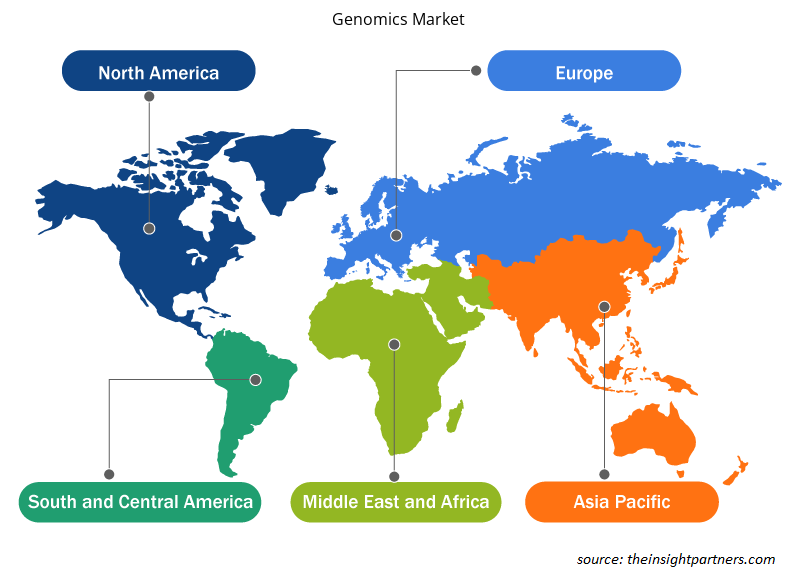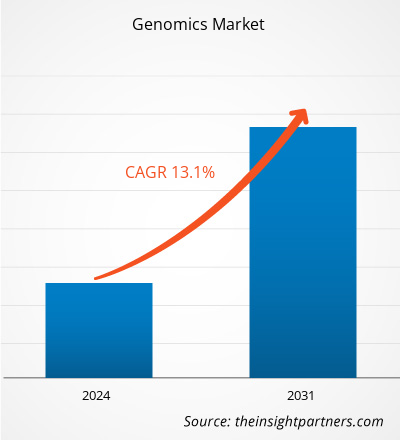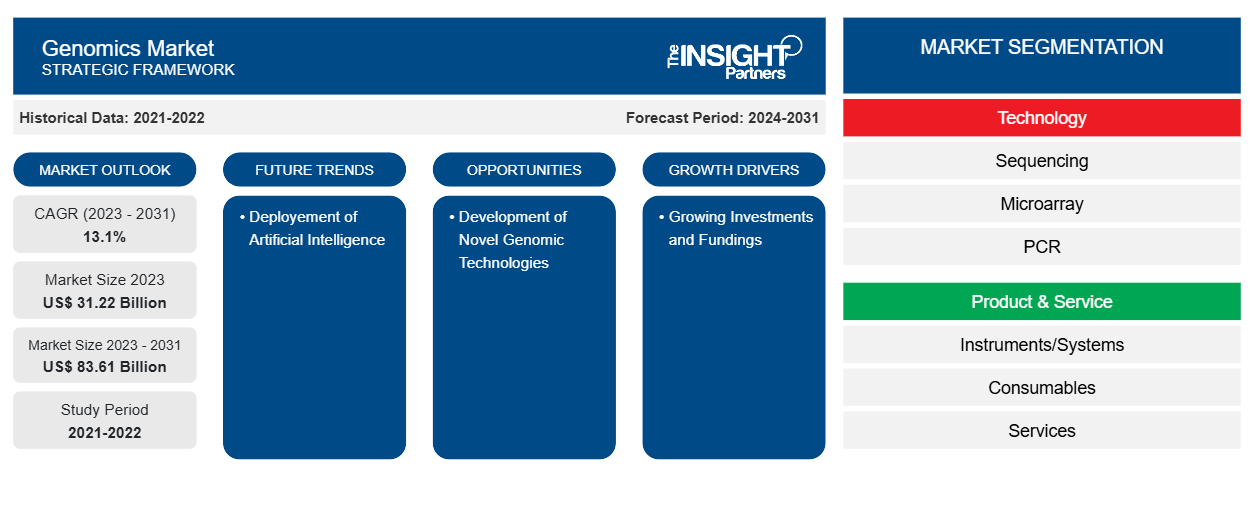基因组学市场规模预计将从 2023 年的 312.2 亿美元增至 2031 年的 836.1 亿美元。预计 2023-2031 年市场复合年增长率将达到 13.1%。基因组学新技术的开发和人工智能的使用可能仍是基因组学市场的主要趋势。
基因组学市场分析
基因组学是分子生物学的一个领域,研究人类基因组的结构、功能、进化和映射。它在个性化医疗、疾病风险预测、药物相互作用研究、环境微生物探索、生物燃料生产、家谱评估、法医学和农业等领域有广泛的应用。随着基因组学领域的投资和资金不断增加,越来越多的初创企业预计将有利于基因组学市场的增长。
基因组学市场概况
正如英国生物产业协会 2022 年发布的《基因组国家报告》所强调的那样,2017 年至 2021 年间,基因组学领域的公司共筹集了 18.5 亿英镑(19.8 亿美元)的风险投资。其中 39.2% 的资金是在 2021 年筹集的。具体来说,基因组公司在 2021 年通过 53 笔交易筹集了 7.18 亿英镑(7.7023 亿美元)的风险投资,其中包括在此期间退出的公司。对研发活动的日益重视正在促进基因组学市场的扩张。
定制此报告以满足您的需求
您可以免费定制任何报告,包括本报告的部分内容、国家级分析、Excel 数据包,以及为初创企业和大学提供优惠和折扣
-
获取此报告的关键市场趋势。这个免费样品将包括数据分析,从市场趋势到估计和预测。
基因组学市场驱动因素和机遇
基因组测序程序的成本效益有利于市场
近年来,下一代测序价格大幅下降。成本的快速降低有助于以更快的速度和更低的价格开展临床研究。这可能会吸引初创公司关注消费者的健康。根据 2022 年 1 月在 Frontiers 上发表的一篇文章,一项研究观察了美国一组 6 名新生儿重症监护病房 (NICU) 患者,这些患者通过快速全基因组测序 (rWGS) 进行诊断,住院时间缩短了 124 天,总住院费用节省了 803,200 美元(每名婴儿约 19,000 美元)。
人工智能——个性化医疗的机遇
人工智能的使用已经改变了基因组学领域。这些技术正在帮助研究人员和科学家分析和解释大量基因组数据。因此,人们不断取得新发现,个性化医疗也正在不断进步。用于临床基因组学应用(如基因组诊断、预后和治疗)的人工智能解决方案正在改变医疗保健。人工智能和基因组学正被用于检测与特定疾病相关的基因突变和生物标记,从而为患者制定个性化的治疗策略。genomic data. As a result, new discoveries are being made, and personalized medicine is advancing. AI-powered solutions for clinical genomics applications, such as genomic diagnostics, prognostics, and therapeutics, are transforming healthcare. AI and genomics are being utilized to detect genetic mutations and biomarkers linked to particular illnesses, allowing for the creation of personalized treatment strategies for patients.
基因组学市场报告细分分析
有助于基因组学市场分析的关键部分是技术、产品和服务、应用和最终用户。
- 根据技术,基因组学市场分为测序、微阵列、PCR、核酸提取和纯化等。测序领域在 2023 年占据了更大的市场份额。
- 根据产品和服务,市场分为仪器/系统、消耗品和服务。仪器/系统部分在 2023 年占据了最大的市场份额。
- 从应用方面来看,市场分为诊断、药物研发、精准/个性化医疗、农业和动物研究等。诊断领域在 2023 年占据了市场主导地位。
基因组学市场份额按地区分析
基因组学市场报告的地理范围主要分为五个区域:北美、亚太、欧洲、中东和非洲、南美和中美。
北美一直主导着基因组学市场。先进测序方法在医疗保健领域的应用日益广泛、各学术和研究机构的广泛研发活动以及生物制药和生物技术公司对 DNA 合成技术的需求不断增长等因素推动了北美基因组学市场的增长。此外,政府在精准医疗领域加大基因组测序的力度和资金投入,预计将进一步刺激市场增长并带来可观的收入。预计未来几年亚太地区将以最高的复合年增长率增长。
基因组学市场区域洞察
Insight Partners 的分析师已详细解释了预测期内影响基因组学市场的区域趋势和因素。本节还讨论了北美、欧洲、亚太地区、中东和非洲以及南美和中美洲的基因组学市场细分和地理位置。

- 获取基因组学市场的区域特定数据
基因组学市场报告范围
| 报告属性 | 细节 |
|---|---|
| 2023 年的市场规模 | 312.2亿美元 |
| 2031 年市场规模 | 836.1亿美元 |
| 全球复合年增长率(2023 - 2031) | 13.1% |
| 史料 | 2021-2022 |
| 预测期 | 2024-2031 |
| 涵盖的领域 |
按技术分类
|
| 覆盖地区和国家 |
北美
|
| 市场领导者和主要公司简介 |
|
基因组学市场参与者密度:了解其对业务动态的影响
基因组学市场正在快速增长,这得益于终端用户需求的不断增长,而这些需求又源于消费者偏好的不断变化、技术进步以及对产品优势的认识不断提高等因素。随着需求的增加,企业正在扩大其产品范围,进行创新以满足消费者的需求,并利用新兴趋势,从而进一步推动市场增长。
市场参与者密度是指在特定市场或行业内运营的企业或公司的分布情况。它表明在给定市场空间中,相对于其规模或总市场价值,有多少竞争对手(市场参与者)存在。
在基因组学市场运营的主要公司有:
- Illumina 公司
- 丹纳赫
- F.霍夫曼-拉罗氏有限公司
- BIO-RAD 实验室公司
- 通用电气公司
- 赛默飞世尔科技公司
免责声明:上面列出的公司没有按照任何特定顺序排列。

- 了解基因组学市场的主要参与者概况
基因组学市场新闻和最新发展
基因组学市场通过收集一手和二手研究后的定性和定量数据进行评估,其中包括重要的公司出版物、协会数据和数据库。以下是基因组学市场的发展列表:
- Illumina, Inc. 与红杉资本中国合作,推出红杉资本中国智能医疗基因组学孵化器,以促进中国初创企业生态系统的发展。该公司创建引擎专注于打造生命科学初创公司,推动基因组学领域的突破性应用。(来源:Illumina, Inc,公司网站,2021 年)
- 安捷伦科技推出了 SureSelect DNA 试剂盒,该试剂盒解决了实验室在为研究准备 DNA 测序文库时遇到的关键挑战。(来源:安捷伦科技,新闻稿,2020 年)
基因组学市场报告覆盖范围和交付成果
“基因组学市场规模和预测(2021-2031)”报告对以下领域进行了详细的市场分析:
- 范围内所有主要细分市场的全球、区域和国家层面的市场规模和预测
- 市场动态,如驱动因素、限制因素和关键机遇
- 未来的主要趋势
- 详细的 PEST/波特五力分析和 SWOT 分析
- 全球和区域市场分析涵盖关键市场趋势、主要参与者、法规和最新市场发展
- 行业格局和竞争分析,涵盖市场集中度、热点图分析、知名参与者和最新发展
- 详细的公司简介
- 历史分析(2 年)、基准年、预测(7 年)及复合年增长率
- PEST和SWOT分析
- 市场规模、价值/数量 - 全球、区域、国家
- 行业和竞争格局
- Excel 数据集
近期报告
客户评价
购买理由
- 明智的决策
- 了解市场动态
- 竞争分析
- 客户洞察
- 市场预测
- 风险规避
- 战略规划
- 投资论证
- 识别新兴市场
- 优化营销策略
- 提升运营效率
- 顺应监管趋势























 获取免费样品 - 基因组学市场
获取免费样品 - 基因组学市场